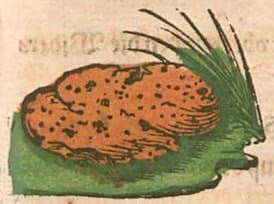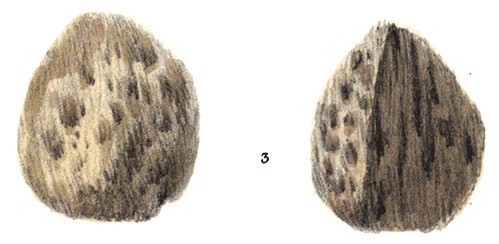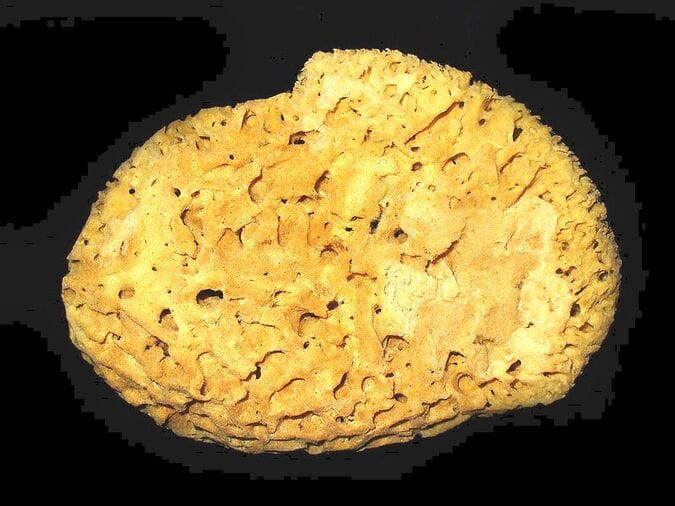Spongii, Sponge
 Krauterbuch, Lonitzer, 1578
Krauterbuch, Lonitzer, 1578 Spongia officinalis
Spongia officinalisMedical Zoology and Mineralogy, Stephendon, 1832
 Spongia officinalis
Spongia officinalisPhoto by Liez
Botanical name:
Various Species of Sponge.
- Spongia officinalis (“Official”, “Commercial” or “Bath” Sponge)
- Spongia lacinulosa (of the Red Sea, Mediterranean and Indian Ocean).
Parts used:
1. Whole dried Sponge
2. Sponge ashes
3. Sponge stone, a stone at the center of the Sponge.
“The fresh Sponge is the strongest and highly desiccant due to the temperament of Sea water”. (Avicenna)
Temperature & Taste:
Cold, dry. Salty
“Hot in the First and Dry in the Second degree”. (Avicenna)
Salmon (Botanologia) said ‘It is temperate in respect of Heat or Coldness, dryness or moisture’.
Classifications:
Aperitive, Abstersive, Diuretic, Nephritic
Constituents:
Many sponges contain good levels of sterols and terpenoids. Sponges are also a rich source of amtibacterial agents. They also contain good levels of trace minerals including Iodine.
Spongia officinalis is a rich source of triterpenoids with proven antimicrobial and antifungal activity. It also contains mucopolysaccharides, gelatin and minerals: sodium chloride, calcium phosphate, sulphur, iodine, silica, aluminium
Uses:
1. Clears Phlegm and Heat, Resolves Masses:
-Scrofula, Swollen Lymph Nodes and Lymphadenitis
-Goiter
-‘… for ‘tis certain, that in this distemper [scrofula] many remarkable cures have been performed by it’. (Pharmacopoeia Universalis, R. James, M.D., London, 1743)
-Burnt Sponge was also for congealed or stagnant Blood
-Sponge may be decocted; Sponge ashes were most commonly used in powder form
-“It desiccates phlegmatic swellings”. (Avicenna)
2. Clears Damp, Promotes Urine, Clears Stones:
-Gravel and Stones of the Bladder and Kidneys. (Sponge, Sponge Stone, Sponge ashes)
-Strangury
3. Clears Heat and Toxin:
-skin inflammation and sores, Boils, Acne, Eczema
-also for Stomach pain, Colic
4. Externally:
-burnt Sponge makes an excellent Tooth Powder.
-stops bleeding topically; sterilized sponge was used until late 19th century to stop bleeding during surgery.
-“Its ashes stop bleeding from a cut or rupture”. (Avicenna)
-“It is soaked in Vinegar and applied on Wounds”. (Avicenna)
-“For healing of deep Wounds, it is placed on them after it has been boiled in Honey”. (Avicenna)
-Red bloodshot or watering Eyes (ashes mixed with wine and applied)
Dose:
Powdered Sponge and Burnt Sponge may be given in similar doses.
Of the Powder or Ashes: 1–3 grams
Preparation:
1. Washed Sponge:
Wash and clean, tie it with a string when still wet and dry carefully, then keep in a dry place.
2. Prepared Sponge
i. Wash, clean, dry. Then cut into long strips and dip into egg white before drying. (Pharmacopoeia Hispana, 1798)
ii. Wash, clean, dry. Then cut into long strips and dip into mucilage of gum arabic before drying. (Pharmacopee Usuelle, Louvain, 1821)
3. Scorched Sponge.:
Dry the Sponge by a fire or in an oven until very dry and yellowish. Then Powder and keep for use.
5. Burnt Sponge:
Wash, dry, cut into small pieces to remove foreign matter, then enclose in a covered iron vessel and burn until black and friable, then reduce to a very fine powder. (London)
Substitute:
Kelp can be used instead of Sponge.
Correctives
1. Ginger
2. Pepper
3. Aniseed
Main Combinations:
1. Scrofula:
i. Sponge with Madder
ii. Sponge with Figwort
iii. Sponge with Pumice and Cuttlebone
iv. Sponge with Juniper and Rose hip
v. Burnt Sponge, calcined Cuttlefish bone
vi. Burnt Sponge (3 oz.), calcined Cuttlefish bone, calcined Egg shell, Rock Salt, Galls, Ginger, Long Pepper, Pellitory of Spain (1 oz. each) (Helmonts Powder of Sponge)
vii. Burnt Sponge, Pill Millipedes, Potassium nitrate
2. Goiter and Testicular swelling, Burnt Sponge, Tartar, Alum, Pumice (Pharmacopoeia extemporanea, Augustin, 1822)
3. Testicular Fibroids, Burnt Sponge, Cinchona (Materia Medica Animalia, 1858)
4. Asthma, Sponge ashes with Fumitory, Gum Ammoniac, Flower of Sulphur (Formulaire Magistral et Memorial Pharmaceutique, 1823)
5. Congealed Blood, Sponge with Madder, Lacca, Rhubarb, Red Earth
Major Formulas:
Powder of Burnt Sponge (Gabelhover)
Powder for Scrofula (Pharmacopoea Argentorarensis)
Powder for Scrofula (Arnold de Villa Nova)
Powder for Scrofula (Palestra Pharmaceutica)
Powder for Scrofula (Bononiense)
1. Compound Powder of Sponge:
i. Sponge powder, Hog Lice (Pill Millipedes) (1 oz. each), Powders of Crabs Eyes, of Winter Cherry (½ oz. each). Mix.
Used for Stone, Gravel, Strangury, Scrofula, Goiter
Dose: 2–4 scruples in Wine, twice daily. (Salmon)
2. Anti-Strumous Powder:
i. Burnt Sponge (3 oz.), White Sugar (1 oz.). Mix. Dose: ½–1 dram, 2–3 times daily. (Dispensarium electorale Hassiacum, 1806)
ii. Burnt Sponge (6 drams), Oleosaccharum of Anise (4 drams). Mix. Dose: 30–50 grains, twice daily. (Nouveau Formulaire Medicale et Pharmaceutique, 1820)
iii. Burnt Sponge, Calcined Sponge Stones (equal parts), Mix. Dose: ½ scruple–2 scruples. (Niemann)
iv. Black Beans (8 oz.), Sugar Candy (4 oz.), Sponge (6 oz.). Burnt together in a covered vessel and powder. Dose: ½ dram. (Nouveau Formulaire Medicale et Pharmaceutique, 1820)
v. Burnt Sponge (1 oz.), Calcined Cuttlefish bone, Sugar Candy (½ oz. each). Mix. Dose: 1–2 scruples. (Pharmacopoeia Sardoa, 1773)
vi. Burnt Sponge (9 oz.), Potassium Sulphate (2 oz.), Swallow-wort root (1 oz.), Cinnamon (2 drams). Mix. Dose: 1–2 scruples. (Pharmacopoeia Wirtembergica, 1798)
vii. Madder (1 scruple), Burnt Sponge (½ scruple). Mix for a dose. (Pharmacopoeia extemporanea, Augustin, 1822)
viii. Burnt Sponge, prepared Wood Lice (½ oz. each), Potassium Nitrate, Corsican Sea-Moss (2 drams each), White Sugar (½ oz.). (Dispensatorium Pharmaceuticum, 1777)
ix. Sponge, Rose hip (2 oz. each), burn to ashes. To every ounce of the ashes add: Cinnamon (½ oz.), Burnt Pepper (2 drams), Red Coral (1 and a ½ drams), Mix. (Niemann)
Cautions:
Cold, so not suitable for Cold constitutions or weakness of the Stomach.
Main Preparations used:
Sponge ashes
ANTIBACTERIAL:
–”the extracts of a large number of sponges showed broad spectrum antibiotic activity”. Triterpenoids form Spongia officinalis have proven antimicrobial and antifungal activity. Avarol tsolated from Disidea spp. showed antibacterial activity and was also active against AIDS (Bioactive Marine Natural Products, Bhakuni & Rawat, 2005). Numerous other species have shown similar effects but are not generally known as sources of medicinal sponge.
